In the 50 years since the Democratic Reform in 1959, Tibet achieved big-leap-forward development in the economic, social and cultural fields. Such a development could be summarized in this way: Moving from darkness to brightness, from backwardness to progress, from poverty to well-off life, from despotism to democracy, and from being closed to opening to the outside world. Like people of other ethnic groups throughout China, the Tibetans enjoy all rights given by the PRC Constitution and laws, and the right to exercise regional ethnic autonomy. At present, of the members of the government institutions at the autonomous regional, prefectural (city) and county levels, 77.97 percent are of the Tibetan and other ethnic minority groups. The Standing Committee of the People's Congress of the Tibet Autonomous Region has, since 1965, enacted some 250 local rules and regulations, and resolutions and decisions of the legal nature.
From 1959 to 2008, Tibet's GDP rose from 174 million Yuan to 39.2 billion Yuan. Calculated according to comparable prices, it was a 65-fold increase, with the GDP increasing at a double-digit rate for 16 years. Tibet's 2008 GDP averaged more than 14,000 Yuan per capita. Calculated in accordance with comparable prices, the figure represented a 27-fold increase over the 1959 figure (142 Yuan). In the same period, Tibet's population increased from 1.228 million in 1959 to 2.8708 million in 2008. People of the Tibetan and other ethnic minority groups made up more than 95 percent of the population in Tibet. The average life expectancy of the Tibetans increases from 35.5 years in 1951 to 67 years today. The school attendance rate in the Tibet Autonomous Region is 98.5 percent for primary schools, 92.2 percent for middle schools, 51.2 percent for high schools, and 19.7 percent for schools of higher learning. Traditional Tibetan culture receives due protection and development, and the broad masses of the people in Tibet enjoy freedom of religious belief according to the PRC Constitution and laws.
It is the strategic decision of the Central Government to mobilize the whole country to aid Tibet in its social and economic development. From 1951 to 2008, the State invested more than 100 million Yuan in construction of infrastructure in the autonomous region. Also in the period, the central revenue's financial transfer payment to Tibet reached 201.9 billion Yuan. After 1994, the Central People's Government organized some 60 Central Government institutions, 18 provinces and municipalities directly under the Central Government, and 17 Central enterprises to provide aid to Tibet's economic construction. All these combine to push forward the socio-economic development in Tibet.
Photo 5-1

All citizens in Tibet who have reached the age of 18 have the right to vote and the right to stand for election, regardless of ethnic group, race, sex, occupation, family background, religious belief, education, property status or length of residence.
Photo 5-2

Picture shows the proportion of Central financial subsidies to Tibet from 1959 to 2008.
Photo 5-3
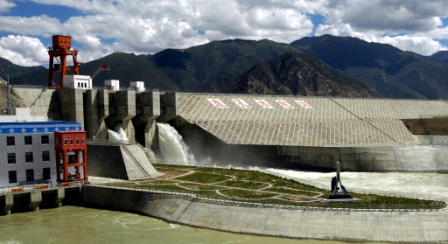
In June 2001 the Fourth National Conference on Work in Tibet held by the CPC Central Committee and the State Council decided to undertake 117 aid projects in Tibet, with a total investment of 31.2 billion Yuan. Picture shows the largest of these projects--the Zhikung Hydraulic Power Station undertaken during the 10th Five-Year Plan. Construction of the project started in May 2003. It has gone into operation, and now generates some 400 million kwh of electricity annually.
Since the Democratic Reform in 1959, Tibet has built large amount of electric power infrastructure, making full use of the rich resources of waterpower, geothermal heat, solar energy and wind energy; electricity thus generated basically meet the need of the economic development. Particularly in the last 20 years, the rapidly-developing electric power undertakings become the "filling station" for Tibet's economic development.
In 2004, the total installed generating capacity of the electric power stations in Tibet reached close to 500,000 kw with an annual electricity generation of 1.2 billion kwh, basically realizing that each county in Tibet has access to electricity. Moreover, a transmission network based on the power grid of central Tibet and over 500 small hydropower stations under the power grid were established. By the end of 2007, the total installed capacity of the power grid at prefectural and city levels managed by the Tibet Electric Power Co. Ltd. amounted to 436,000 km, including 400,000 km hydropower, 11,600 kw thermal power, and 24,000 kw power generated by geothermal heat. At the end of 2007, the power grid at and above the prefectural and city levels had 17 110-kv transformer substations with a total capacity of 582,500 kva and 1,797 km 110-kv transmission lines. There were 52 35-kv transformer substations with a total capacity of 384,000 kva and 1,546 km of 35-kv transmission line.
Photo 5-4

Picture shows the Liuwo Highway Bridge spanning across the Lhasa River, which links Lhasa with the Railway Station.
In old Tibet there was not one highway in the modern sense. Today, there is a coordinated development of the transport network, with highways as the center, and supported by aviation, railways and pipelines. It is centered around Lhasa and radiates to other parts of Tibet. Recent years saw faster development of highway construction, with progress made in renovation of the Sichuan-Tibet Highway, the Yunnan-Tibet Highway, the Xinjiang-Tibet Highway, the China-Nepal Highway and other trunk highways. Remarkable progress has been made in construction of highways leading to counties and villages. National and regional highways play a bigger role in social and economic development today.
In 2008, all counties in Tibet had access to highways, with the highway mileage adding up to 51,300 km, or 44,000 km more than 1959 (7,300 km); passenger transport capacity was 107 times that of 1959; and goods transport was more than 11 times that of 1959.
Photo 5-5

Picture shows the Qinghai-Tibet Highway, which is hailed by the Tibetans as "auspicious heavenly road".
For long time, the outlying position and inconvenient traffic have been key factors which restrict the economic development of Qinghai Province and the Tibet Autonomous Region. Without railways, over 85 percent of goods were transported to Tibet through the Qinghai-Tibet Highway. However, the highway transportation could hardly meet the rapid social and economic development of Qinghai and Tibet and in particular that of Tibet. Hence, the Central Government decided to build the Qinghai-Tibet Railway.
The Qinghai-Tibet Railway spreads 1,956 km from Xining City in Qinghai Province in the north to Lhasa City in the Tibet Autonomous Region in the south. It is the longest railway on a plateau with the highest altitude in the world. About 965-km-long section of the railway is paved on the area above 4,000 meters high. The highest point is located in the area with an elevation of 5,072 meters on the Tangula Mountain. Some 550-km-long section is paved on the land of permafrost and 216-km-long section on the seismic area exposed to magnitude 9 earthquake. On July 1, 2006, the Qinghai-Tibet Railway was open to traffic fully. During the two years of its operation, the amount of goods transported increased obviously compared to the same period in the past, and the number of visitors to Tibet also increased steadily. By the end of March 2008, all together 1.411 million tons of goods had been transported into Tibet, 173,000 tons of goods transported out of Tibet through the railway. A total of 2.653 million people have been transported through the Qinghai-Tibet Railway, including 1.297 million transported into Tibet and 1.356 million transported out of Tibet.
Photo 5-6
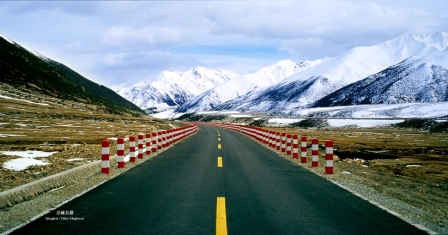
Picture shows the Qinghai-Tibet Highway.
Extending from Xining in Qinghai to Lhasa in Tibet, the highway links Tibet with the hinterland of China. More than 85 percent of goods were transported into Tibet via the highway, and more than 90 percent of the goods were transported out of Tibet also by the highway. Given the role it plays in Tibet's social and economic development, the highway is hailed as "the lifeline of Tibet."
The highway extends 1,160 km and was built in area with an average elevation of over 4,000 meters, including 544 km within Tibet. It cuts it way through the Changtang Grassland in northern Tibet and meets the Sichuan-Tibet Highway in Lhasa.
Photo 5-7

Picture shows the national nature reserve-the Lhalu Wetland in Lhasa.
Tibet is the ecological safety barrier to China and Asia as a whole.
The State has always attached great importance to ecological conservation in the plateau region and puts hefty investment into the construction of the State ecological safety barrier project on the Tibet Plateau. The Central Government plans to spend more than 10 billion Yuan to implement the Plan for the State Ecology Safety Barrier Protection and Construction on the Tibet Plateau during the 2006-2030 period. Fourteen conservation projects divided into three categories will be launched, covering natural grassland and wildlife protection, planting of grass, the control of desertification and soil erosion, mine reforestation and geological disasters prevention, and ecological monitoring and supervision. The goal is to reconvert some 14.96 million hectares of pasture into grassland, and restore 4.2 million hectares of grassland, enabling 77 percent of medium or above degenerated grasslands to be effectively protected and controlled; to protect native vegetation on 8.34 million hectares of forest, and restore degenerated forest and construct 4.368 million hectares of shelter forest, making the protected and constructed forest land account for 78 percent of the total; and to treat desertification and soil erosion on 306,000 hectares and 3.15 million hectares respectively. In addition, during the 10th Five-Year Plan (2001-2005), the Central Government put about 120 million Yuan into protecting the Lhalu wetland in Lhasa--the highest and biggest urban wetland in the world, the Namco Nature Reserve and Central Nagqu Grasslands. The Central Government and the autonomous regional government allocated 26.77 million Yuan and 11.72 million Yuan respectively to be used to strengthen the construction of Tibetan infrastructure for environmental protection in an all-around way and raise Tibetan capacity to conduct environmental protection.
Photo 5-8
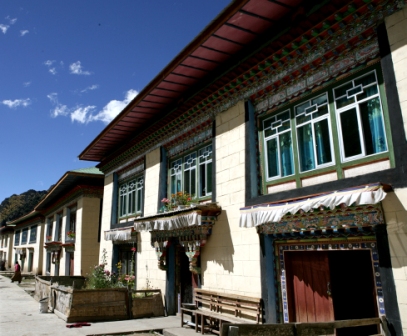
Picture shows housing for the Tibetans today.
The government of the Tibet Autonomous Region has carried out the housing project for farmers and herders. The project, once finished, would mean housing for 80 percent of the region's farmers and herders by the end of 2010.
The housing project for farmers and herders is carried out through "governmental support, other provinces' aid, bank loan and public self-financing". Every farmer and herder family or poverty-stricken household can draw assistance from 10,000 to 25,000 Yuan. In rebuilding, the choice and living customs of the farmers and herders are fully respected.
Tibet actively pushes forward the construction of low-rent and turnover houses. By the end of 2007, the per-capita housing construction area for urban residents in Tibet stood at 32.7 square meters and that for farmers and herdsmen reached 21.7 square meters.
Photo 5-9
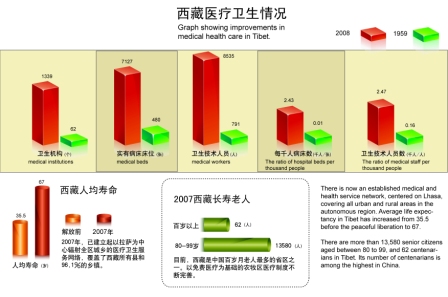
Picture shows healthcare in Tibet.
There were no modern medical and healthcare institutions in Tibet in the old days. By 2008, Tibet had 1,339 medical institutions, up 1,277 compared to 1959; they had 7,127 beds for the sick, and 8,535 medical and technical workers, up 6,647 and 7,744 as against 1959. The rate of hospital beds and medical staff per 1,000 people reached 2.43 and 2.47, up 2.42 and 2.31 respectively. The averaged life expectancy of the Tibetan people increases from 35.5 years before Tibet's Democratic Reform in 1959 to 67 years now. There are more than 13,580 elders aged 80-99, and 62 above 100 in Tibet, making Tibet one of the provinces and regions with most elders over 100.
Tibet becomes the first province or region in China to buy medical insurances for all its urban residents. It has gradually established a system of cooperative medical service in rural and pastoral areas with free medical service as basis. Farmers and herdsmen in Tibet have received free medical care, averaging 140 Yuan per capital annually.
Photo 5-10

Picture shows a teacher with the Tibetan Traditional Medical College and his students.
With the vigorous support of the State and the regional government, research on Tibetan medicine and Tibetan medicine industry has flourished. Tibetan medicine has been listed as one of the three most important industries of the region. According to available statistics, by the end of 2007, there were 14 Tibetan medicine institutions and more than 60 Tibetan medicine departments of the hospitals at the county level, staffed with over 2,000 doctors and medical workers.
Photo 5-11

Picture shows an audio-visual classroom of the Chanang Middle School in Chanang County, Shannan Prefecture.
Over the past 50 years, the State has allocated a huge amount of funds to develop education cause in Tibet, thus making Tibet the first place in China to enjoy free compulsory education in both urban and rural areas. By 2008, the enrollment rate for school-age children rose from less than 2 percent to 98.5 percent, and the illiteracy rate fell from 95 percent to 2.4 percent.
Photo 5-12

Tibetan children are taught Tibetan in primary schools in a traditional way.
Photo 5-13

A shot of the Potala Palace.
Since the 1980s, the Central Government and the government of the Tibet Autonomous Region have allocated a huge amount of funds, totaling more than 700 million Yuan, to protectively repair key cultural relics sites in Tibet, restoring and opening a large group of key historical sites and key monasteries of various sects to the public. From 1989 to 1994, the Central Government allocated 55 million Yuan and a great amount of gold, silver and other precious materials for the repair of the Potala Palace. Beginning in 2001, a special fund to the tune of 330 million Yuan was apportioned to repair the Potala Palace, the Norbu Lingka and the Sagya Monastery. In 2007, the Central Government allocated 570 million Yuan for the repair and protection of 22 key cultural relics sites in Tibet during the 11th Five-Year Program (2006-2010).
Photo 5-14

Picture shows a giant portrait of Buddha being unfolded in the Zhaibung Monastery during the Shoton (Sour Milk Drinking) Festival.
Today, religious followers in Tibet may set up family shrines to worship Buddha at home. They are also free to worship in monasteries. It is a common scene that Tibetan worshippers take ritual walks around holy mountains or holy lakes; devout people hang up sutra streamers, pile up Mani stone mounds, or prostrate themselves along the long way to Buddhist sites. Each year, there are up to a million people worshipping Buddha in the Jokhang Monastery in Lhasa. In addition, religious habits and customs included in wedding or funeral ceremonies are fully respected. Various religious holidays, such as the Grand Summons Ceremony in Lhasa, traditional ritual walk around holy mountains in the Tibetan Year of the Horse, and traditional ritual walk around Namco Lake in the Tibetan Year of Sheep, are celebrated as usual.
Photo 5-15
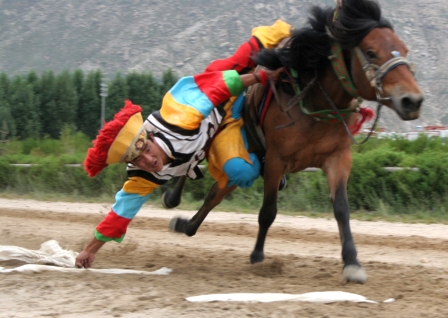
Picture shows the traditional horsemanship-picking up hada scarf while riding on the horseback during a Tibetan festival.
Tibetan traditional folk sports are the outcome of natural physical geography and national living customs. Tibetan rich and colorful folk sports can be found in the mural paintings in the Potala Palace and the Jokhang Monastery and books such as History of the Tang Dynasty: Tubo and the Wedding Banquet of Talented Persons. The farmers and herders take an actively part in the performances during the Dharma Festival in Gyangze, the Bullfight Festival in Bainang County, the Horse Race Fair in Nagqu County, the Kungpo Festival in Nyingchi, the Damgyirinmo in Damxung County, the Bathing Festival, the Tibetan New Year and the Ongkor (Bumper Harvest) Festival. Some of these games have become sport events of China's national sports meat.
Photo 5-16

Tibetan opera is one of the Chinese ethnic minority operas which boast a long history. Its performance features folk dance, singing and talking to show the content of stories, and is hailed as the art gem of Chinese nation. Eight major traditional pieces, such Princess Wencheng, Prince Nuosang and Drowa Sangmo are played throughout the Tibet Autonomous Region and its neighboring Tibetan-inhabited areas in provinces of Qinghai, Gansu, Sichuan and Yunnan. They reflect the life of people in the Tibetan-inhabited areas, exerting a profound impact upon Tibetan society and life.
Photo 5-17

Picture shows famous artist Tubdain singing and talking the Life of King Gesar.
The Life of King Gesar, the longest epic in the world, falls into two parts-text and talking and singing part. The Life of King Gesar shows the theme of helping the oppressed and suppressing the oppressor, weeding out the wicked and letting the law-abiding citizen live in peace, and doing harm to the interests of the ruling class. Its creators and performers had no social status in old Tibet where religious culture had the reigning status. With the wolf at the door, many of them had to move about and give performances to eke out a living. After the Democratic Reform in 1959, the Central Government attached importance to the protection of the intangible cultural heritages in Tibet. A group of artists and specialists were brought together to rescue and collect the versions of the Life of King Gesar. Special efforts have also been made to discover and cultivate King Gesar talking and singing artists. Up to now, there are more than 140 King Gesar talking and singing artists found across China.

















